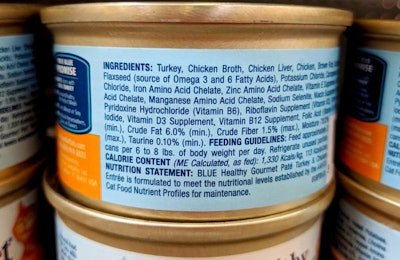
At the Association of American Feed Control Officials (AAFCO) meeting in August 2020, the Ingredient Definitions Committee (IDC) did not have time to discuss two items of major impact on the pet food industry. One pertained to the potential discontinuation of use of menadione sodium bisulfite complex (MSBC), a source of vitamin K activity, in pet foods. The other was a proposal to replace the declaration of vitamins on pet food labels from their current "chemical-sounding" names to arguably more consumer-friendly albeit less informative "common vitamin names." These items were subsequently discussed in an IDC teleconference in October.
More about MSBC’s status in pet food
The issue re: MSBC has been previously discussed (see Petfood Industry magazine, April 2020). Briefly, although MSBC is not officially sanctioned for use in dog or cat foods (or in feeds for any other species beyond poultry, for that matter), the industry has come to rely on its inclusion in formulations for many decades, wholly unfettered by regulatory concern. In fact, it is the only reliable source of vitamin K activity that is readily available when such supplementation becomes required for fish-based complete and balanced cat foods under the AAFCO Nutrient Profiles. There are also many other situations where inclusion of a vitamin K source is nutritionally prudent if not essential per se.
Despite this long-standing discretionary arrangement, one state is now pondering action against all pet foods (and presumably, feeds for other non-poultry species) containing MSBC, not because of any indication of a safety issue but because of a regulatory technicality. Some other states appear to be joining in, with efforts to make this a nation-wide enforcement policy via AAFCO.
No immediate enforcement action is contemplated, but for that to remain the case is contingent on industry's expedited submission of data to formally document safe use; e.g., a Generally Recognized As Safe (GRAS) Notice for each intended species. Frankly, because there has never been a compelling need to generate such data for publication before, finding suitable evidence in the published literature now would be onerous at best. One regulator characterized this matter as "holding industry's feet to the fire," but in considering MSBC's very long history of safe use, it may be better described as "pulling the rug out from under industry." In any event, due to considerable consternation as to the way this matter is proceeding, the plan for the immediate future is for continuation of discussion. Hopefully, an amicable solution that will satisfy the needs of all parties can be reached.
Changing vitamin names on pet food labels
The proposal to change the names of vitamins on pet food labels reportedly stems from the results of a consumer focus group held as part of AAFCO's Pet Food Labeling Modernization efforts. In the study, consumers reportedly favored an ingredient list which included the "common vitamin names" over the current nomenclature or a combination of the two. Thus, it was proposed that simplistic terms such as "vitamin B2" and "vitamin C" replace "riboflavin" and "L-ascorbyl-2-polyphosphate," respectively.
Notwithstanding arguments that "the consumer wants it," there are numerous problems with such a change, not the least of which is that it would contradict current federal law (under Food and Drug Administration regulations, "pyridoxine hydrochloride" and not "vitamin B6" would be the "common or usual name" of that ingredient). Also, many times the source of the vitamin matters significantly; e.g., beta-carotene would be a good source of vitamin A in dog foods, but essentially worthless in cat foods. Finally, many potential sources are not approved in the U.S., and/or are not recognized for nutritional purposes. For example, mixed tocopherols technically is a form of vitamin E, but it is used predominantly for its preservative properties rather than for any significant nutritive value. Thus, to represent it as "vitamin E" on a label would be false and misleading in several respects.
As proposed, the declaration in simple terms would only apply to the final pet food label, and state feed control officials would still have the opportunity to review product formulations to ensure that safe and appropriate sources of vitamins were used. Theoretically, then, many of the potential discrepancies mentioned above could be caught and remedied. However, as a practical matter, regulators already struggle with sizable burdens on resources (multiple tens of thousands of label review submissions each year), so it would be hard-pressed to expect states to have the capabilities to take on these additional duties.
At the IDC teleconference, another option was proposed: to allow for a prominent "common vitamin name" to be declared but followed with a parenthetical of the true ingredient name; e.g., "Vitamin B1 (Thiamine Mononitrate)." This is not too far from a format already tacitly acceptable ["Thiamine Mononitrate (source of Vitamin B1)"] but in a somewhat friendlier and succinct manner of presentation. While further discussion at the next AAFCO meeting is expected, this option may be garnering broad support.
Briefly: Top 5 takeaways
- AAFCO’s Ingredient Definitions Committee had two more issues to tackle after the Annual Meeting: potential discontinuation of the use of MSBC in pet foods and the renaming of vitamins on pet food ingredient labels.
- Although MSBC is not officially sanctioned for use in dog or cat foods, the industry has come to rely on its inclusion in formulations.
- The industry may be hard-pressed to quickly come up with data to prove MSBC’s “safe use” in pet food formulations simply because it’s never been needed before.
- The proposal to change the names of vitamins on pet food labels comes from the results of a consumer focus group held as part of AAFCO's Pet Food Labeling Modernization efforts.
- Even if “the consumer wants it,” is being held forth as an argument, the situation is more complicated than changing names, from running afoul of federal law to being misleading in terms of what function a vitamin plays in a formula.
















